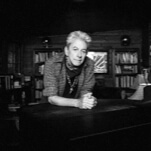R.E.M.

Geek Obsession: R.E.M.
Why it’s daunting: It’s hard to claim a band as popular as R.E.M. has a daunting discography. But the group has constantly shifted identities throughout its career, never settling too long in one place. While some signature elements have remained identifiable throughout R.E.M.’s career—Bill Berry’s lock-step drumming (up to a point, at least), Peter Buck’s jangly guitar chimes, Mike Mills’ sweet harmonies and melodic basslines, Michael Stipe’s distinctive vocals—the group has also continually tinkered with that sound, resulting in a sprawling discography filled with sonic shifts.
Rising from indie label I.R.S. in the early ’80s to become one of the world’s biggest bands, R.E.M. has altered its sound as it saw fit over the years. After early success that culminated in the panoramic arena rock of the band’s 1988 major-label debut, Green, guitarist Peter Buck put down the Rickenbacker and picked up a mandolin. After those next two albums, Out Of Time and Automatic For The People, made the group critical and commercial darlings, Buck put the mandolin away and started using distortion pedals, and the band went in a hard-rock direction. R.E.M. has never had qualms about making these choices, and in some respects, it’s paid the price for it. After signing a five-album, $80 million deal with Warner Bros. Records in 1996, the band saw its popularity fade as founding member and drummer Bill Berry left and the remaining trio of Stipe, Mills, and Buck stumbled through uncharted territory in the late ’90s and early ’00s. They stretched their sonic muscles trying to find the right sound for this next phase, alienating fans who had jumped on board during the band’s commercial peak.
Possible gateways: Murmur and Automatic For The People
Why: As with many obsessions, the best places to start are at the beginning and the peak. And the beginning was Murmur, a rock album as dense with Southern gothic atmosphere as the kudzu that graces its cover. From the first snare hits of the propulsive lead-off track “Radio Free Europe” through the nervous, kinetic energy of album closer “West Of The Fields,” Murmur immerses the listener in another world. Stipe’s famously mumbled lyrics remain a mystery to many almost 30 years later, but his voice is still able to evoke a range of emotions—desperation, sadness—even if the exact words remain open to interpretation. Elements like the tinkling piano on “Perfect Circle,” Buck’s jangly, circular line on “Talk About The Passion,” and the soaring chorus to “Catapult,” however, need no further explanation.
Almost 10 years after the release of Murmur, Automatic For The People became one of R.E.M.’s bestselling albums and one of its greatest critical successes. Focusing on the themes of mortality and loss and featuring string arrangements by Led Zeppelin’s John Paul Jones, Automatic is a lush masterpiece. “Drive” opens the album on an ominous note, a subdued dirge that gives way to “Try Not To Breathe,” a shuffling rumination on dying. The album is also home to two of the band’s most-loved songs: the gorgeous, nostalgic piano ballad “Nightswimming,” and the country-tinged Andy Kaufman tribute “Man On The Moon,” which Peter Buck has called “the quintessential R.E.M. song.” While many of R.E.M.’s albums are cohesive, Automatic is one where the thematic elements and atmosphere combine to create an artistic work that, taken as a whole, is greater than the sum of its parts.





















![Rob Reiner's son booked for murder amid homicide investigation [Updated]](https://img.pastemagazine.com/wp-content/avuploads/2025/12/15131025/MixCollage-15-Dec-2025-01-10-PM-9121.jpg)


















